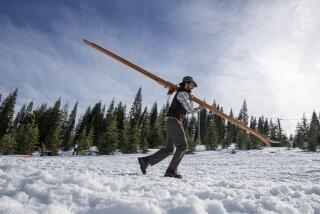Winning Can Be Hit or Myth : World’s Best Pilots of Hang Gliders Get a Lift by Competing in the Owens Valley
- Share via
BISHOP, Calif. — Where hang gliding began is vague because it seemed to evolve over the ages from man’s dream to fly like a bird.
In Greek mythology, Icarus was flying with his father, Daedalus, when he flew too near the sun, melting the wax he used to fasten his feathered wings to his body. He crashed, becoming the first hang gliding fatality and giving the sport a bad name.
If Icarus were competing in the current World Hang Gliding Championships here, he would be wearing a parachute, as modern hang glider pilots do. The risks are the same, especially in the Owens Valley, where humans perhaps have become more closely attuned to their feathered friends than anywhere on earth.
Pilots often follow redtail hawks into thermal updrafts to altitudes of 18,000 feet. Mark Gibson of Bishop, a member of the six-man U.S. team, once flew 258 miles from Lone Pine to Lovelock, Nev., a world record at the time.
But it’s tricky. The thermals they seek are treacherous--so powerful they can throw a 75-pound hang glider out of control.
G.W. Meadows, who runs a hang glider operation at Kitty Hawk, N.C., where the Wright brothers flew, said, “This is the Banzai Pipeline of hang gliding.”
Australian team leader Clive Gilmour calls it “the best place (and) the most dangerous place. But this is the Mecca of hang gliding.”
Chris Arai, a member of the U.S. team who has flown the Owens Valley for 15 years, said, “One of the reasons the world championships haven’t been held here until now is because the Owens Valley has a reputation of being big and gnarly. That was true in the old days, relative to what we were flying. The equipment we have now and the skills we have, it’s not anywhere near as dangerous, (although) you can get yourself into a scary situation if you’re not experienced with it.”
Brad Koji was weary but happy as he debriefed over a plate of pasta in an Italian restaurant, explaining how one wins a hang glider race in the Owens Valley, as he had that day.
“Maybe two dozen hit the north end of the range within half an hour after the tarp,” he said. “The lift was good. We climbed out real quickly. Boundary (Peak) was really rough and turbulent. You didn’t want to hang around, so we (flew) on to Basalt. We were fairly low, and that’s where you start going out into the flatter ground and we were concerned about how strong the lift was going to be.
“The first gaggle was well above us with a slightly different course line. We got some fairly good lift--maybe four or five hundred feet a minute--and climbed several thousand feet. Then we pressed northward and got some real good lift, like 1,000 feet a minute, and we blazed up to 18,000.”
“Actually,” Arai interrupted, “17,890 on my altimeter. We aren’t supposed to fly (as high as) 18,000 (because of FAA regulations).”
Koji continued: “Seventeen nine ninety-nine. At that point we thought we might be able to glide all the way to goal, (which was) 25 miles out. We hit the edge of a cloud streak, porpoised across that, pushed out on the lift and just dove for the goal at Luning.”
Koji, of Littleton, Colo., and Arai, of Oakland, were 1-2 that day. They are among 159 pilots from 32 countries and six continents competing.
Modern hang gliding evolved in the late 1960s from the experiments of NASA scientist Francis Rogallo with flexible wings and Australian daredevil water skier Bill Moyes with manned kites originally towed by boats.
Then some theorized that they could be launched over ground.
“They built a few, but couldn’t get anybody to fly them,” Moyes said. “I became the original test pilot. I got my share of broken bones.”
He also spent two days in an Arizona jail for trying to promote hang gliding with a flight through the Grand Canyon. The activity eventually got a foothold in Southern California and spread around the globe.
The world championships have been held about every two years since 1976, but are in the United States for the first time. And this may be the first time the United States will win a team or individual title. This week Arai, in one of the two divisions, and the United States were in first place overall, followed by Australia, Germany and the United Kingdom.
Not that anyone would know it. Hang gliding is one of those obscure adventure sports whose main notoriety comes from accident reports.
U.S. team leader Pete Lehman of Pittsburgh says there is much more to it, including “the combination of the beauty, the grandeur, the intellectual complexity . . . you’re not just jumping off a cliff and killing yourself, (a perception) which infuriates me.”
There also is a language barrier, even when they are speaking English.
The tarp is the large, blue plastic thing spread out at the start and finish--the goal-- so pilots can see it from several thousand feet up.
A lift is a thermal updraft, a column of hot air rising from the ground, usually up the face of a sun-warmed mountainside.
A gaggle is a group of gliders soaring together, rather than going off on their own in search of private lifts.
The task is the race course assigned the day of each race, based on wind and weather conditions. Some measure 80 miles, following the White Mountains north through the Owens Valley and out over the Nevada desert.
Generally, only a third to two-thirds will make it, because a race is a repetitive sequence of gaining enough altitude in one thermal and circling like a bird to be able to glide to the next thermal--if you can find it.
“You can’t see air,” one pilot said. “Except maybe in L.A.”
A British pilot, Bruce Goldsmith, parachuted down from his disabled glider on the first day. Among steep, rocky cliffs, he was fortunate to land in a patch of snow at 10,000 feet, suffering only bruises. He started walking out before rescuers reached the site an hour later, showed up in the valley the next morning--and flew again that day.
“It’s not bowling,” said Arai, who at 35 is about the average age for the top competitors. “Hang gliding people are totally enamored with being able to fly like a bird. At the same time, it’s always been a taboo: You’re going to die if you try to do it . . . the story of Icarus and Daedalus.”
There isn’t much money in it. Asked if one could make a living hang gliding, Meadows said, “That depends on your definition of a living. “
“I’m probably the highest paid hang glider pilot who ever lived,” said Robert Combs, one of the event’s organizers.
But he made his money by doing chewing gum commercials--actor, stunt man and technical adviser.
Defending champion Tomas Suchanek of the Czech Republic says he won about $8,000 in Brazil two years ago. These competitors are flying for stained-glass trophies. Fortunately, Bishop has several inexpensive motels and an unlimited selection of fast food. The Russian team is camping out in a small oasis at the airport.
Few complain. The older pilots remember Brazil’s Paulino Coelho when he emerged from the ghettos of Sao Paulo to work for change helping them set up their gliders for local meets. Now he has placed third and fourth in the last two world events.
The stronger teams are equipped with two-way radios to talk to chase vehicles on the ground. All must carry cameras to verify their start, finish and checkpoint positions. Some carry two cameras, for good reason: Without photographic proof, disqualification is automatic.
It takes an hour to drive to the launch site on Gunter Peak at the end of a dirt road at 8,200 feet, about 4,000 feet above the valley floor. The White Mountains are more barren than the Sierra on the other side of the valley, but reach as high as 14,242 feet, only 213 feet lower than the Sierra’s Mt. Whitney, the highest point in the Lower 48. Boundary Peak, at 13,140, is the highest point in Nevada.
At Gunter, near the ancient bristlecone pine forest, the pilots launch their gliders in two groups by running a few steps downhill into a headwind.
First off are a couple of wind technicians, commonly called “wind dummies”--non-competing pilots whose mission is to show the others what the conditions are. Then the competitors launch and circle up the thermals to altitudes of 12,000-14,000 feet, where they start breathing oxygen and need flight suits to protect them from freezing temperatures. Sometimes they rise as fast as 2,000 feet per minute--faster than an express elevator. At the given time, they move in a gaggle toward the starting point, and the race begins.
On the ground, their chase crews follow them along U.S. 6. and fret like mother hens.
Ron Newland, whose son Mark is one of Australia’s top pilots, said, “If they go down out here, they won’t last very long.”
Turning east into Nevada, pilots who have “decked out,” unable to reach the goal, are seen along the road, folding up their gliders or using them for shade until their chase teams arrive. Newland finds team member Drew Cooper waiting.
Cooper gets in and takes over the radio.
“Carl (Braden), are you and Mark still climbing or are you gliding down the ridge?”
“Negative. We’re trying to climb, but it’s bloody slow.”
Then: “We just got into some pretty nice air.”
They will reach the goal in the middle of a dry, barren salt marsh near the Tonopah rest area. Two other teammates from the first group are already there, but Russell Duncan is unaccounted for.
An hour and a half later, as the sun settles low, Braden says, “He’s lost, I’d say.”
Someone comments that it must have been like this waiting for Lindbergh at Orly Airport. But five minutes later, there’s a speck in the sky, and soon Duncan glides across the tarp.
Gilmour advises him, “Russell, I figure (waiting for) you cost us three beers apiece, so that’s 12 you got to buy.”
It’s a 100-mile drive back to Bishop. For all but the driver, who abstains, the beer tastes good. Tomorrow, they fly again.
Like the birds.
More to Read
Sign up for Essential California
The most important California stories and recommendations in your inbox every morning.
You may occasionally receive promotional content from the Los Angeles Times.













